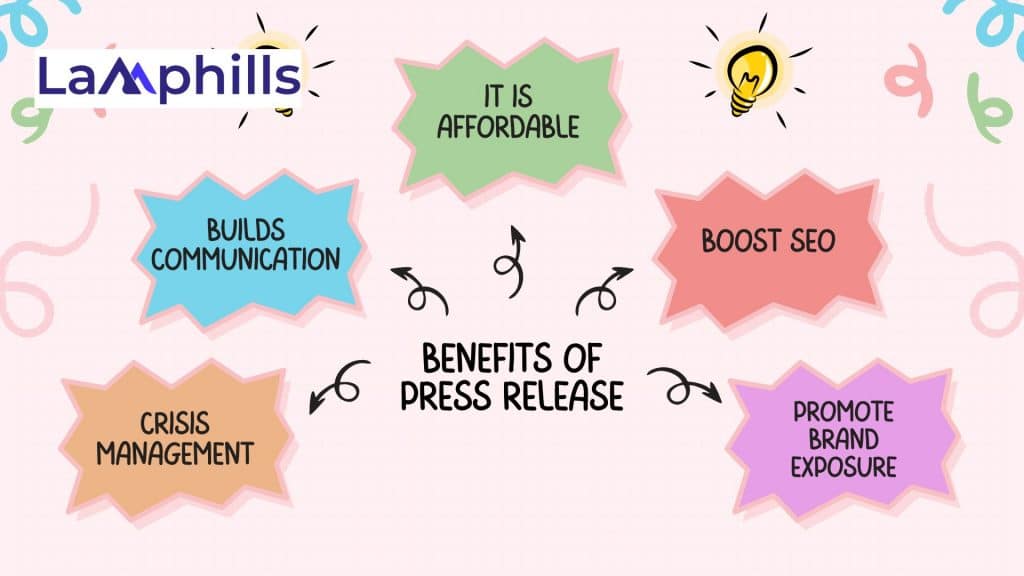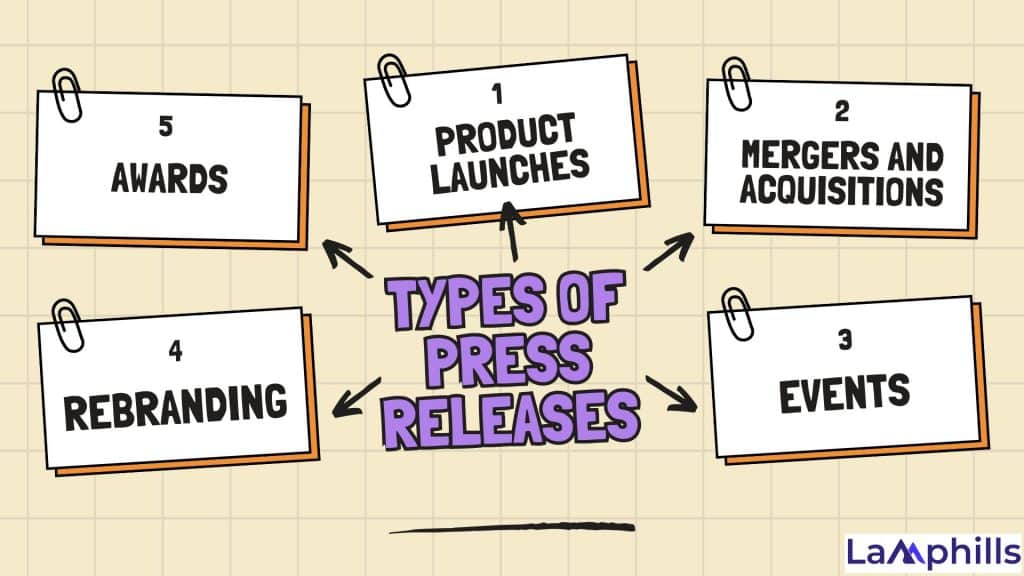Hello, welcome. Today, I’ll teach you how to write a press release. I’ll also provide examples and templates so you can start right away. Stick around, okay?
You know, in a busy society of public relations, getting noticed is important. I remember early in my career, I found out that even the most exciting news might be ignored if the press release wasn’t well-written. This led me to improve my skills, focusing more on clear and engaging messages.
Now, having created successful press releases for over thirty brands, I’ve learned effective strategies. In this article, I will share some great press release examples of 2024. These examples will show you how to announce new products, important events, and partnerships in a way that sends out information and connects with your audience.
At the end of this article, you’ll learn:
- All about Press Release, including,
- The Benefits of Press Releases
- Types of Press Releases
- Sample/Format of Press Release
- How to Write a Press Release
- Tips for Publishing Press Releases
Let’s get started!
Key Notes
1. A press release is a document that shares important news or information about your brand that journalists might want to report on, giving them all the necessary details.
2. Press releases are affordable, they boost SEO, promote brand exposure, build communication with investors and stakeholders
3. The common press release examples include announcements for new product launches, mergers and acquisitions, product updates, events, grand openings, new partnerships, rebranding, executive promotions/hiring, and awards.
4. A standard press release format includes a catchy headline, subheadline, release date and location, introductory paragraph, body paragraphs, quotes, calls-to-action, boilerplate, end notation, and attachments.
What is a Press Release?

A press release is a document that shares important news or information about your brand that journalists might want to report on, giving them all the necessary details.
Some media outlets might publish your news just from the press release itself. Others might reach out to you for an interview or ask for your expert opinion on a different story, especially if you often send out press releases about interesting news.
Just saying “Look at my business!” isn’t enough to make the news.
Remember that press releases are public, so anyone, including your stakeholders and customers, can see them. Instead of just using them to get media attention, think of them as an important part of your marketing content.
Writing a press release takes some effort, including good writing skills and a communications manager. However, the benefits for your company are huge because it means free publicity.
Read Also: Press Release Boilerplate: Writing An Effective Copy
Benefits of Press Release

Beyond just getting media attention, writing a press release has several advantages, some of which are including;
#1. It is affordable:
First, it’s an affordable option for your marketing toolkit, especially if you’re a startup on a tight budget. Posting releases online can also attract potential customers and increase links back to your website.
#2. Boost SEO:
When press releases are shared online, they can improve your search engine rankings. Including relevant keywords and links in your press release can make your website more visible in search engine results.
#3. Promote Brand Exposure:
Press releases help increase brand awareness by sharing news, updates, or achievements about your company. This can attract potential customers and enhance your brand’s visibility and content marketing.
#4. Builds Communication with Investors and Stakeholders:
Press releases are a great tool for keeping investors, shareholders, and other important stakeholders updated about major company news, financial results, or new strategies.
#5. Crisis Management:
A well-crafted press release lets you control your narrative. You can highlight what matters most to you and emphasize your value. If there’s ever a crisis, a press release gives you a way to share your side of the story.
In addition to all these benefits, it is advisable to share your press releases on your website’s news or press page. This not only makes you look more professional but also establishes you as an expert in your area. Reporters visiting your site will find it easier and faster to access relevant information, saving them time.
While there are no laid down rules for what a press release must contain, here are some events that can guide you in shaping your press release and deciding what information will best share your news. This brings us to the types of press releases.
Types of Press Releases

Here’s a list of things you might want to talk about using a press release:
- New Product Launches
- Mergers and Acquisitions
- Product Updates
- Events
- Fundraising
- Grand Openings
- New Partnerships
- Rebranding
- Executive Promotions/Hiring
- Awards
Product Launches
A product launch press release is used to spread the word about your organization’s new products. It should highlight the product’s features, price, availability, and any other relevant information that might interest consumers.
Mergers and Acquisitions
Changes in your organization, like mergers and acquisitions, are noteworthy and should require a press release. This should include details about the companies involved, specifics of the merger or acquisition, and statements from the leadership teams.
Product Updates
For updates or expansions to existing products, use a press release to explain what has changed, why the change was made, and how it benefits users.
Events
Use press releases to promote events, detailing what the event involves, who should attend, and when and where it will take place, including any costs.
Grand Openings
If you’re opening a new office, relocating, or opening for the first time, announce it with a grand opening press release. It is necessary to mention the opening date, location, participants, how it will be celebrated, and why you are moving, if relevant.
New Partnerships
Announcing new partnerships through a press release can benefit all parties involved. Include a summary of each company, the purpose of the partnership, who benefits from it, and other crucial information for stakeholders.
Rebranding
Rebranding can be challenging and may confuse customers. You can make the transformation easy by issuing a press release that details what is changing, why the change is happening when it will happen, and include comments from the leadership.
Executive Team Changes
Changes in the executive team can be significant, as these individuals often represent the company. When writing a press release, be sure to include their background, credentials, a photo, and other relevant information to introduce them to the public.
Awards
It’s good to highlight achievements with press releases that announce awards. Include details about the award, the reasons your company received it, and information about the award ceremony if there is one.
Read Also: BEST FREE PRESS RELEASE DISTRIBUTION WEBSITES IN 2024
Before you start writing your press release, it’s important to understand the different formats used for press releases.
Formats of Press Release
Here are the formats to write a well-detailed press release.
#1. Page/Layout Settings
For a standard press release layout, set 1-inch margins on all sides of the document (top, bottom, left, and right). Use single spacing for the body paragraphs and choose a clear, standard business font such as Arial or Times New Roman. If you’re using an already-made template, your document will already be formatted according to industry/official standards.
#2. Company or Brand Logo:
Increasing your brand’s visibility is often the main reason for sending out different types of press releases. To make your press release more effective at promoting your brand, place your company logo at the top of the document, centered in the header so it stands out.
When you email your press release, make sure to attach a version of your logo that works well online so that journalists can easily use it in their articles. This prevents journalists from having to pull the logo from the press release themselves. Alternatively, you can provide a link to all the multimedia elements related to your story at the end of your press release, after the standard company information.
#3. Release Date or Dateline
Put the date and time you want your press release published under the logo on the left side, in all caps and bold. If the press release should go out immediately, write “FOR IMMEDIATE RELEASE” at the top left corner.
If you want journalists to wait before publishing the press release, use an “embargoed” release. Write “EMBARGOED FOR RELEASE” at the top left-hand corner and specify the release date and time. Make sure this date matches the one in the first paragraph of the press release.
#4. Contact Information
Many people think the best outcome is for the media to publish their press releases exactly as submitted. However, what you want is for the media to write a full article about your story.
Therefore, it’s important to include contact details for someone who can provide more information about the noteworthy news your press release covers, as well as about your company. You should ideally include:
- Contact Person’s Name
- Contact Person’s Title
- Company Name
- Phone Number
- Email Address
- Complete Website URL
This information should be justified to the left but placed toward the right side of the page.
#5. Headline and (optional) Subheading
The standard format for a press release includes a catchy main headline and an optional sub-headline, which appear below the logo, contact details, and the release date at the top.
Your main headline should be bold, centered, and in 14-point font size. Keep it short, ideally between 65 to 80 characters, and use straightforward language. The headline is crucial because it grabs attention and makes people want to read more. It needs to spotlight the most vital and interesting part of your news—the reason your audience would find it relevant.
The sub-headline should be placed under the main headline, using a 13-point, italicized font. It can be slightly longer than the main headline (up to 120 characters) and should add an interesting detail about the story. When you send your press release to journalists who reach your target audience, clear and appealing headlines can increase the chances of your story being published.
#6. Location and Date
In the first paragraph of your press release, separate the location and date with a dash. Start with the location, usually a city, in all capital letters, followed by the state abbreviation. Include the full date next—month, day, and year. Both should be bolded. Format it like this: CITY, ST (Month Day, Year).
For example, the location and date for a press release from Los Angeles, California, would look like this:
LOS ANGELES, CA (May 14, 2024) – (The rest of your press release content)
#7. Introductory Paragraph
Focus on the key facts in the first paragraph of your press release and highlight why your news is important. Avoid using exaggerated claims, promotional phrases, or statements you can’t prove, these mistakes can make journalists trash your press release. Use a clear, 12-point Arial or Times New Roman font and single space in this and all following paragraphs.
Often, the first paragraph is the only part that journalists and readers might look at. To make sure they get all the information they need to follow up (like covering your story or attending your event), add links in this paragraph to your website or related documents.
#8. Body Paragraph
The next few paragraphs of your press release should finish the story you started in the headline and first paragraph. Focus on what makes your story important and provide more details and background that journalists can use.
Keep your paragraphs short, about two to four sentences each. You can also include statistics and graphics to support your points and make your announcement more interesting. Finally, include details that make it very easy for journalists to report on your story.
#9. Include Quotes
To write an effective press release, it is important to include one or two quotes from a company leader or representative. These quotes do more than just share facts, they give your press release a personal touch.
For instance, you might include a statement from your CEO like:
“We’re excited to build another manufacturing plant here in Milwaukee,” said CEO Peters Elo. “This continues our long-standing commitment to this great city and its excellent workforce.”
Writers usually use two quotes in their press releases to give journalists different perspectives for their articles.
#10. Calls-to-action
This part tells the reader what to do next and how to do it. For example, if the press release announces a new book release, the call-to-action could encourage readers to order a copy online or visit their local bookstore to purchase it.
This section usually includes a website link, phone number, email, or physical address for further action.
#11. Boilerplate
The boilerplate section of your press release provides information about your company and lets you include some basic details about your business.
This section is called “boilerplate copy” because it is usually reused in every press release the company sends out.
For example, here’s the standard boilerplate copy that Nike often includes:
“Since 1964, Nike has been a leader in athletic footwear and apparel, dedicated to innovation and inspiring athletes worldwide. With a commitment to creating quality products for both professional athletes and casual sports enthusiasts, Nike continues to be a pioneer in the sports industry. Our mission is to bring inspiration and innovation to every athlete in the world. For more information, visit us online at nike.com.”
#12. End Notation
The last part of a press release format includes three-pound signs (###) centered at the end. This shows the media that they have reached the end of the document, in journalistic terms. Try to keep your press release to one page, or about 500 words. If it needs to be longer and goes onto a second page, put “-more-” centered at the bottom of the first page.
#13. Attachments
Using a press release distribution service allows you to attach files to your release. Here are some examples of attachments you might include:
- A brief video about your event or product
- Your logo
- A photo of the product you’re launching, the new building, the newly appointed CEO, etc.
- An infographic
- A PDF of an ebook, report, or case study
Ensure these files are small enough to meet each site’s size limits and that images are 300 dpi for print media quality.
It’s also useful to have a webpage or online media kit where journalists can download the original multimedia files included in your story. When you email your press release, include links to these original files so journalists can access them in the best quality, not just as smaller, lower-quality versions.
How to Write a Press Release
Sharing big news about a company through a press release can be a big boost for the business, but it’s really important to get it right. Here’s a step-by-step guide on how to write a press release just like the one we talked about:
- Create an engaging headline.
- Include a subheadline for extra details.
- Show why your news matters to the media.
- Include an interesting quote.
- Add useful background information about the topic.
- Summarize the key details and players in a boilerplate.
- Add your contact information.
- Check for errors before publishing.
#1. Write a catchy headline
Think of a short, attention-grabbing title for your news. Use action words, keep it brief, and make it interesting to stand out from other announcements, just like the headlines you see in the publication you’re targeting.
#2. Add more info with a subheadline
The subheadline gives more detail about the news. Summarize your press release in one sentence to support the headline and encourage people to keep reading.
#3. Include the release date and location
Tell them when and where. Say when the news is coming out and where your business is. This makes it clear and important. Also, many news templates say “FOR IMMEDIATE RELEASE.” That means journalists can share the news right away.”
#4. Explain why it’s important
After the intro, provide more info in order of importance, keeping it simple and direct. Make sure your press release explains why people should care about your news. Start with the most important info first and then add more details.
#5. Include a quote
Add quotes that add personality and depth to your story, attributing them correctly, especially a quote from someone important in your company to give context to your news.
#6. Provide extra details
Add any other important info that helps explain your news, like how you came up with the idea or what it means for the future.
#7. Summarize who you are
Add a short description of your business at the end, like what you’d find on your website’s “About” page, like what you do, along with contact info. Make sure it’s up to date.
#8. Give contact info
Help reporters contact you easily by giving them your contact details. Tell them clearly who they can contact for more information, like their name, email, phone number, and social media
#9. Include a brief business summary
Add a short description of your business at the end, like what you’d find on your website’s “About” page. Make sure it’s up to date.
#10. Wrap it up properly
End with a standard sign-off like ###.
#11. Check for mistakes
Proofread your press release to make sure there are no errors and that it’s easy to understand. You can also use tools to help improve clarity and coherence.
By following these steps, you can make sure your press release gets noticed and understood by journalists and readers alike.
Press Release Examples
Here are some templates and press release examples you might want to use.
#1. New Product Press Release Template
Introducing a new product to your lineup is always exciting. You should announce it as soon as you’re ready to spark interest, boost sales, and get early signups. This press release template from TechGenius Inc. helps you do that clearly while highlighting the benefits and features for customers.
You can also include when the product will be available, its price, and where to find more information. This crucial information helps attract early potential customers.
#2. Startup Fundraising Press Release Template
Use this template to announce your business’s new fundraising round. Include quotes from an investor and your representative, along with the reasons for the fundraising.
Raising funds is crucial for your startup at any stage, whether you are developing or more established. If you are starting a new funding round, even with previous rounds completed, it’s important to inform the public.
This press release template will help generate excitement about your company and attract angel investors interested in growing startups.
#3. Rebranding Press Release Template
By including these elements, a rebranding press release effectively communicates the changes and the reasons behind them, helping to ensure a smooth transition and positive responses from the target audience.
#4. Crisis Communications Press Release:
This example of a crisis press release is from Niya Collection. This release addresses the Perfume Contamination Issue.
Tips for Publishing Press Releases
Writing a press release is only the first step. After creating it, you need to focus on how to distribute it. We all know the usual ways to share press releases: posting them on your website or blog, and sharing them with your followers on social media and through email.
To reach a wider audience, follow these tips:
#1. Target Specific Journalists
Instead of sending your press release to every journalist you find, focus on a few who cover your industry. Send them personalized messages showing how your news fits their interests.
Note: Use services like Meltwater’s press distribution, which connects you with the right journalists.
#2. Send the Release to Top Journalists a Day Early
Give journalists time to prepare their stories by sending your press release to them a day before it goes live. Mark it “under embargo,” which means they can’t share the information until your specified time.
#3 Avoid Publishing on the Hour
When using a distribution service like PR Newswire or Business Wire, avoid releasing your press release exactly on the hour. Many companies do this, so your release might get overlooked. Instead, choose a unique time, like 1:12 p.m. or 3:18 p.m.
#4. Share Your Media Coverage
If your press release gets media attention, keep the momentum going by sharing the articles that news outlets write. Share these stories on your digital channels, such as social media and email, to keep people interested in your announcement.
Wrapping Up.
In summary, a good press release is a strong way to share your news and get media attention. Focus on clear and brief content to communicate your message and engage your audience. Make sure your press releases are relevant, timely, and suited to your target audience to have the best impact. By following this guide, you’ll create a successful press release.
FREQUENTLY ASKED QUESTIONS.
What are the 7 main components of a press release?
The seven key parts of a press release are the release date, contact information, a headline and subheadline, the story’s location and date, the main content, a brief company description, and an end mark. You can also add your business logo, quotes, and multimedia elements.
What are the 7 steps to a press release?
Step 1: Find a Newsworthy Angle
Identify a topic that interests your audience. Check popular articles for ideas.
Step 2: Set a Clear Goal
Decide what you want to achieve with the press release (e.g., announce a change, or launch a product).
Step 3: Write a Catchy Headline
Create a short, engaging headline. Use numbers and question words like “what,” “why,” or “how.”
Step 4: Craft Your Story
Start with key information. Use short paragraphs, headers, bullet points, and images. Include quotes and data, and avoid jargon.
Step 5: Add a Call to Action
Include links to your website and social media. Provide contact details if needed.
Step 6: Include a Boilerplate
Add a brief “about” section about your organization.
Step 7: Attach an Image
Include a relevant image in both portrait and landscape formats to grab attention.
How do you write a PR brief?
1. Overview: Summarize your PR campaign with relevant business details. Include:
- Campaign duration
- Target audience
- Budget
- Key strengths and features
2. Goals: Specify your campaign goals. Define what your brand wants to achieve, such as raising awareness or boosting sales.
3. Audience: Identify your specific target audience and share relevant data or market research to help the PR team reach them.
4. Focus: Decide on the key message you want to convey. Ensure it’s clear, honest, and supports your campaign goal.
5. Measuring Success: Outline how you’ll measure success. Include KPIs, metrics, and realistic timeframes to track progress and ROI.
What is a Press Release?
A press release is an official message sent to news media to share information, make an announcement, or provide a statement to the public. It is a primary source, meaning it offers original information.
How do you write the first sentence of a Press Release?
Start with a summary of your news. Include the key details and make sure to cover the five Ws: who, what, where, when, and why.
Related Articles:
How to Write News Release: Free Tips and Examples






